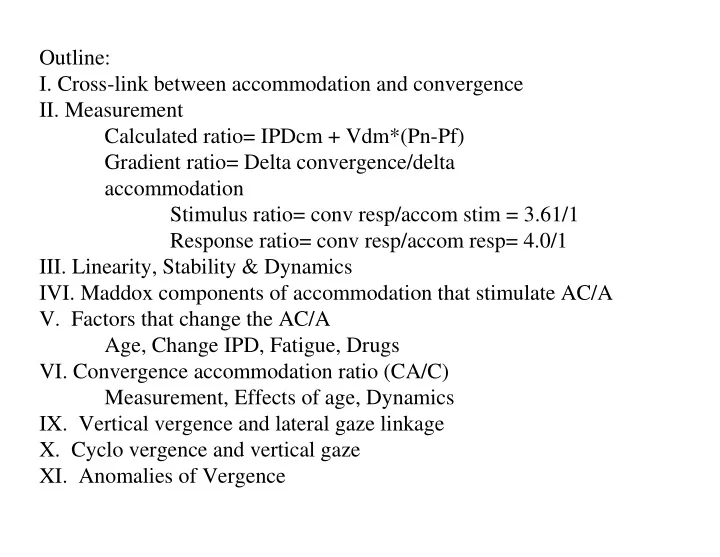

Outline: I. Cross-link between accommodation and convergence II. Measurement Calculated ratio= IPDcm + Vdm*(Pn-Pf) Gradient ratio= Delta convergence/delta accommodation Stimulus ratio= conv resp/accom stim = 3.61/1 Response ratio= conv resp/accom resp= 4.0/1 III. Linearity, Stability & Dynamics IVI. Maddox components of accommodation that stimulate AC/A V. Factors that change the AC/A Age, Change IPD, Fatigue, Drugs VI. Convergence accommodation ratio (CA/C) Measurement, Effects of age, Dynamics IX. Vertical vergence and lateral gaze linkage X. Cyclo vergence and vertical gaze XI. Anomalies of Vergence
Accommodative Convergence Coordinates the near response 1 deg Position of Left eye 400 ms 1 deg Position of Right eye .25 deg Magnified Position of Right eye to show details more clearly.
Ideal vs empirical AC/A ratio for symmetrical convergence.
Iso Vergence & Isoaccommodation Circles A B C D Ideal AC/A decreases w/ azimuth
Stimulus AC/A ratio 3.6 ∆ / 1D stimulus Response AC/A ratio 4.0 ∆ / 1D response
Normal distribution of the stimulus AC/A ratio
Two clinical measures of the AC/A ratio: Calculated AC/A AC/A = IPD cm + [Phoria (near) – Phoria (far)] x VD m AC/A = IPD cm + [Phoria (near) – Phoria (far)] / MA Gradient AC/A AC/A= change in phoria / change in accommodation AC/A = Phoria without the lens – phoria with 1D lens.
Calculated AC/A IPD = 6cm Pn = -4 exo Pf = +1 eso VD near = 0 .4 m AC/A= 6 + [-4 – 1] / 2.5 = 4/1 IPD= 7 Pn = -4 exo Pf = +1 eso VD = 0.4 m AC/A = 7 + [-4 – 1]/2.5= 5/1
Gradient AC/A Near phoria without added lenses = 3 Exo Near phoria with a +2D added lens = 12 Exo [-3 – (-12)] / 2D = 9/2 = 4.5/1
Linearity of the AC/A ratio Accommodation stimulus-accommodative response function Accommodation stimulus-convergence response function Response AC/A ratio is linear until the amplitude is reached and then it becomes infinite.
Temporal stability of the AC/A ratio over 2 months
Affects of Age on AC/A The AC/A increases with age because the amplitude of accommodation decreases with age and extra accommodative effort is needed near the amplitude of accommodation.
The CA/C ratio is usually not measured clinically because it is not part of the Maddox classification and traditionally it has not been included in the clinical analysis of binocular vision. The CA/C can be measured clinically by stimulation convergence with a photograph of an out-of-focus vertical bar. Its too blurred to stimulate accommodation but it stimulates convergence. Changes of accommodation stimulated by convergence are measured with retinoscopy. Typical values for the CA/C are (1 MA /1 D) in the early 20s, but it declines as the amplitude of accommodation declines with age.
The CA/C ratio decreases with Age (loss of amplitude of accommodation). CA/C = 1D/MA CA/C = 0.5D/MA CA/C = 0.25D/MA
Difference of Gaussians (DoG)
Elevation of AC/A ratio by Atropine Effects of Drugs
Amplitude of the AC/A increases with velocity of Accommodation AC/A=0 ∆ / D AC/A= 4 ∆ / D Dynamics of AC/A
Amplitude of the CA/C increases with velocity of convergence CA/C = 0 D/MA CA/C = 1D/MA Dynamics of CA/C
Fast accommodation stimulates AC/A but slow accommodation does not. Fast and slow accommodation are controlled separately. Fast accommodation is referred to as phasic accommodation. Slow accommodation is referred to as tonic accommodation. Slow accommodation produces adaptive changes of the resting focus.
Fast convergence stimulates CA/C but slow convergence does not. Fast and slow convergence are controlled separately. Fast convergence is referred to as phasic convergence. Slow convergence is referred to as tonic convergence. Slow convergence produces adaptive changes of the phoria.
Not all components of accommodation and convergence stimulate cross-links. Phasic stimulates cross links but tonic does not. The balance of activity of Phasic and Tonic determine the AC/A ratio
Fatigue of accommodation and convergence can cause temporary changes in the AC/A ratio: A high AC/A decreases when tonic convergence is fatigued. A low AC/A increases when tonic accommodation is fatigued. With fatigue, phasic activity is not relieved by tonic adaptation and the cross-link interactions change.
Accommodative convergence is high before fatigue of convergence Accommodative convergence is low after fatigue of convergence
Accommodative convergence is low before fatigue of accommodation Accommodative convergence is higher after fatigue of accommodation
Lab # 2- Accommodative Convergence Accommodat ive Response (Badal Set t ing) E E St ig m a Occlude r Accommodat ive St imulus Convergence Ba da l (1/ dist ) - added lens Angle Lens Align the left stigma with Focus the right stigma to measure accommodation E to measure convergence
Recommend
More recommend